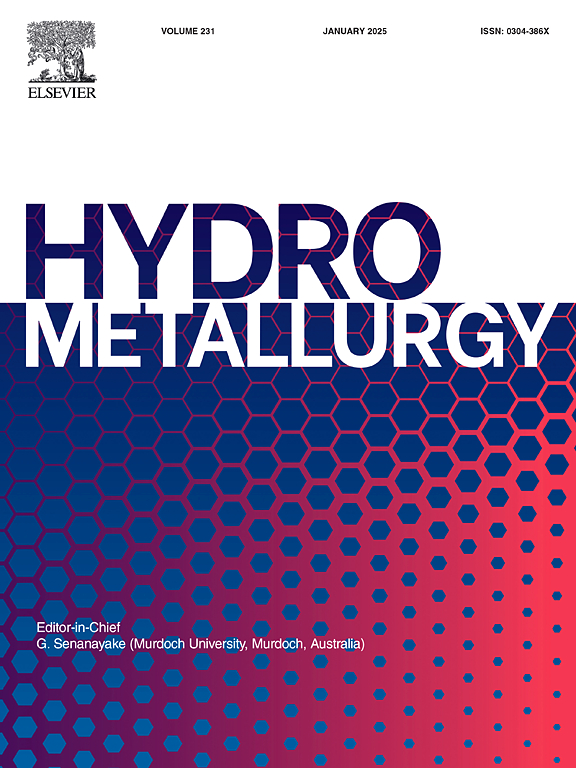Bioleaching and mechanism of ion-adsorption type rare earth ores and tailings using Acidithiobacillus ferrooxidans
IF 4.8
2区 材料科学
Q1 METALLURGY & METALLURGICAL ENGINEERING
引用次数: 0
Abstract
Traditionally, ammonium sulfate (NH4)2SO4 has been utilised as the leaching agent in the extraction of ion-adsorption type rare earth (IATRE) ores. However, this method only extracts rare earth elements (REEs) from the ion-exchangeable phase, leaving behind a substantial amount of tailings that still contain REEs. Therefore, this study explored the bioleaching process of IATRE ores and tailings in the presence of Acidithiobacillus ferrooxidans (A. ferrooxidans) and the reaction mechanism. The results showed that in the two-step bioleaching system, where bacteria were cultured well prior to the addition of minerals for leaching, the extraction efficiencies for La (99.5 %), Ce (78.1 %), Nd (95.8 %), and Y (93.5 %) at a pyrite to IATRE ore mass ratio of 1.5:1 were 23.1 %, 58.3 %, 23.4 %, and 13.8 % higher, respectively, than those obtained using the current (NH4)2SO4 leaching system. X-ray diffraction (XRD), scanning electron microscope coupled with energy-dispersive X-ray spectroscopy (SEM-EDS), and three-dimensional excitation-emission matrix (3DEEM) revealed the bioleaching mechanisms of the IATRE ore. These results demonstrated that the oxidative dissolution of pyrite by A. ferrooxidans promoted the production of acid and Fe2+. This facilitated proton exchange reactions between H+ and IATRE ores, the acid dissolution of IATRE ores, and the reduction of Ce4+ in the colloidal sediment phase. Additionally, bacterial surface groups and extracellular polymeric substances (EPS) produced by the bacteria formed complexes with rare earth ions, facilitating the release of REEs from IATRE ores. Furthermore, A. ferrooxidans successfully extracted REEs from IATRE tailings after leaching with (NH4)2SO4. These findings provide valuable insights into the bioleaching of IATRE ores and present a novel approach for the adequate recovery of REEs from IATRE ores and tailings.

酸性氧化亚铁硫杆菌对离子吸附型稀土矿石和尾矿的生物浸出及其机理研究
传统上,硫酸铵(NH4)2SO4作为浸出剂用于离子吸附型稀土(IATRE)矿石的浸出。然而,这种方法只从离子交换相中提取稀土元素(ree),留下了大量仍含有ree的尾矿。因此,本研究探讨了在Acidithiobacillus ferrooxidans (A. ferrooxidans)存在下的IATRE矿石和尾矿的生物浸出过程及其反应机理。结果表明:在两步生物浸出体系中,先培养细菌再添加矿物进行浸出,在黄铁矿与IATRE矿石质量比为1.5:1时,La(99.5%)、Ce(78.1%)、Nd(95.8%)和Y(93.5%)的浸出率分别比当前(NH4)2SO4浸出体系高23.1%、58.3%、23.4%和13.8%;x射线衍射(XRD)、扫描电镜-能谱仪(SEM-EDS)和三维激发发射矩阵(3DEEM)揭示了IATRE矿石的生物浸出机理,结果表明A. ferrooxidans对黄铁矿的氧化溶解促进了酸和Fe2+的生成。这促进了H+与IATRE矿石之间的质子交换反应,IATRE矿石的酸溶,以及Ce4+在胶体沉积阶段的还原。此外,细菌产生的细菌表面基团和胞外聚合物(EPS)与稀土离子形成配合物,促进稀土从IATRE矿石中释放出来。此外,A. ferrooxidans在(NH4)2SO4浸出后成功地从IATRE尾矿中提取了稀土元素。这些发现为IATRE矿石的生物浸出提供了有价值的见解,并为从IATRE矿石和尾矿中充分回收稀土提供了一种新的方法。
本文章由计算机程序翻译,如有差异,请以英文原文为准。
求助全文
约1分钟内获得全文
求助全文
来源期刊

Hydrometallurgy
工程技术-冶金工程
CiteScore
9.50
自引率
6.40%
发文量
144
审稿时长
3.4 months
期刊介绍:
Hydrometallurgy aims to compile studies on novel processes, process design, chemistry, modelling, control, economics and interfaces between unit operations, and to provide a forum for discussions on case histories and operational difficulties.
Topics covered include: leaching of metal values by chemical reagents or bacterial action at ambient or elevated pressures and temperatures; separation of solids from leach liquors; removal of impurities and recovery of metal values by precipitation, ion exchange, solvent extraction, gaseous reduction, cementation, electro-winning and electro-refining; pre-treatment of ores by roasting or chemical treatments such as halogenation or reduction; recycling of reagents and treatment of effluents.
 求助内容:
求助内容: 应助结果提醒方式:
应助结果提醒方式:


